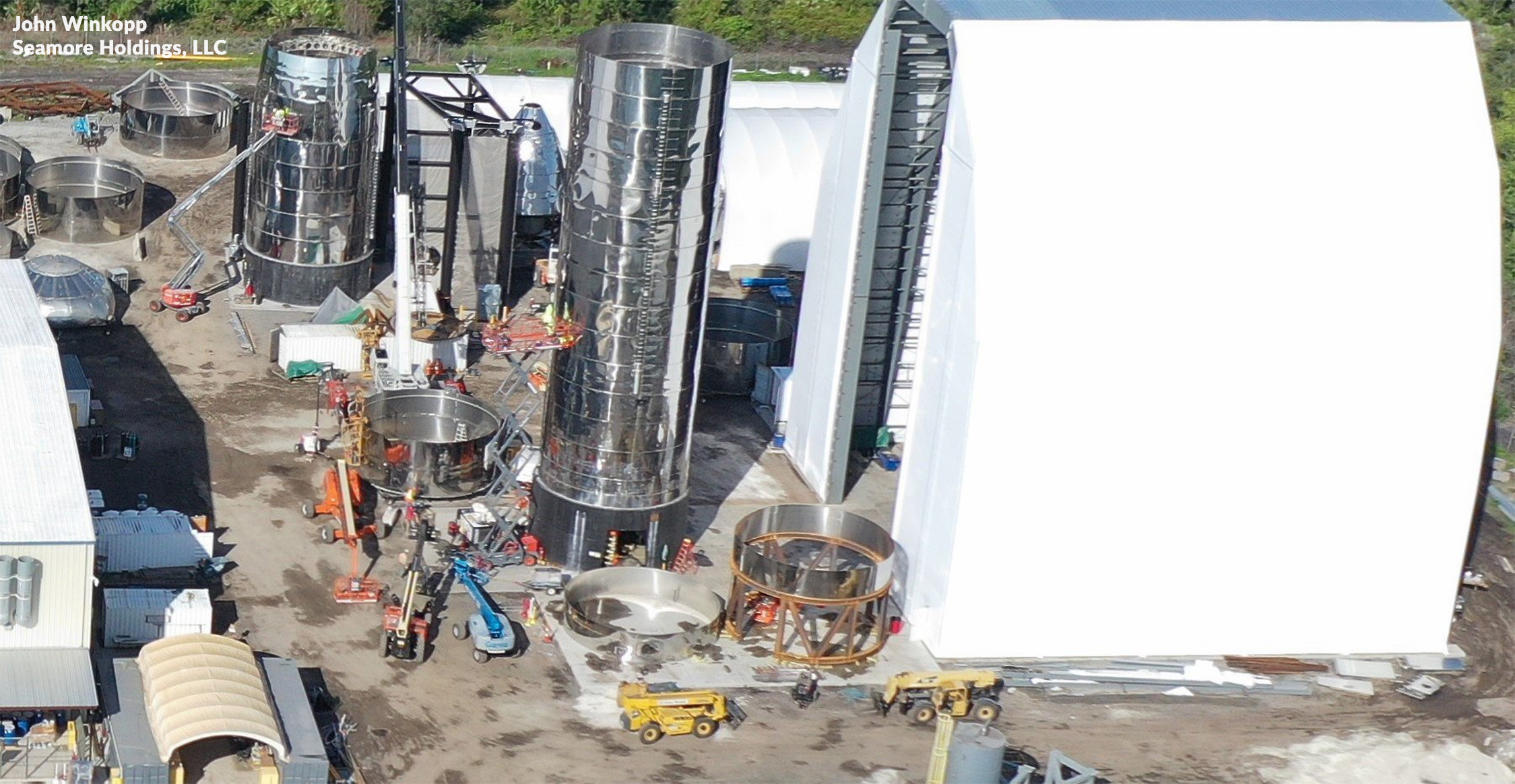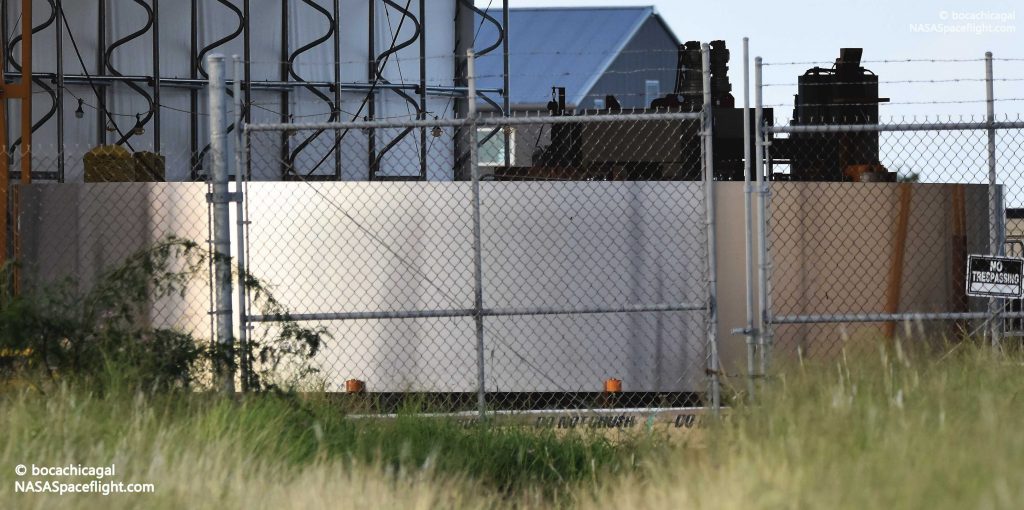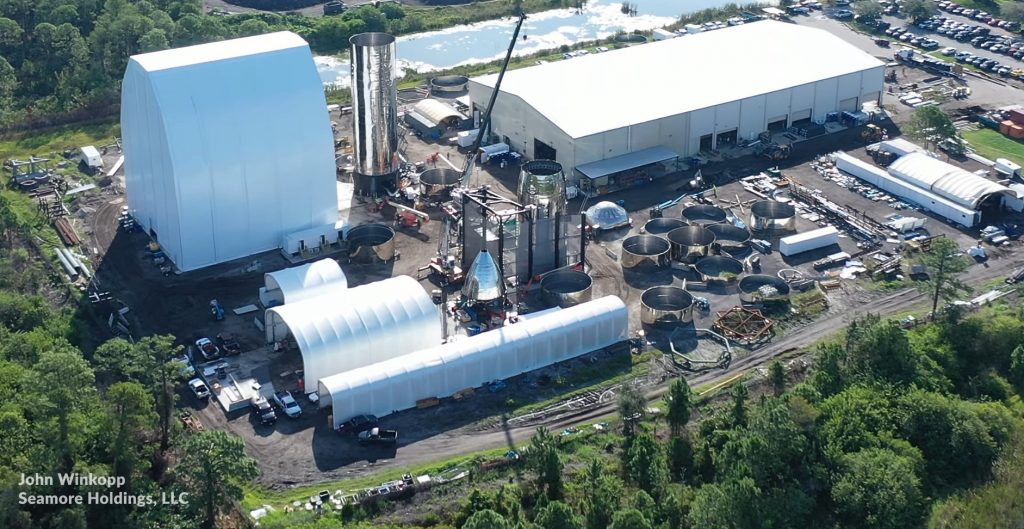

News
SpaceX’s fourth Starship prototype has begun to take shape in Florida
SpaceX’s Florida Starship team appears to have taken the first step towards assembling Starship Mk4, the fourth full-scale prototype of the next-generation spaceship.
Although SpaceX’s Boca Chica, Texas Starship campus is undeniably in the lead with their first prototype, Starship Mk1, it appears that the company’s Florida campus is far ahead of Texas with their second Starship prototype.
At the moment, SpaceX has set up two separate Starship build teams in Florida and Texas with the intention of creating a sort of internal competition to see which group’s Starships are first to flight and first to orbit. For the most part, it’s assumed that this “competition” is less a fight to the finish line than it is an A/B test, a common software development practice in which separate teams pursue different methods of achieving the same goals.
In the likely event that SpaceX is performing a radical form of A/B testing with rocket prototypes, both teams are continuously sharing best-practices and lessons-learned as they work to find the best possible methods for fabricating hardware and assembling Starships. Nevertheless, in A/B testing, fundamentally different approaches also tend to result in development schedules and final products that are unique, even if the end results are similar.
In the context of Starship, this is exactly what can be observed at SpaceX’s Florida and Texas facilities. Similarities abound in the radical method of en plein air manufacturing being implemented, while the Starship Mk1 and Mk2 hardware being built and assembled are also relatively similar, even if they have some distinct characteristics.
For example, it’s been observed that Starship Mk2 has almost certainly been constructed out of steel rings that are significantly taller than those used to assemble Starship Mk1. Taller rings meant that Mk2 needed fewer overall rings to reach the same height as Mk1, a fact that likely contributed to the impressive speed with which SpaceX’s Florida team was able to stack and weld most of Starship Mk2’s aerostructure.
Star(ship)fleet
According to SpaceX CEO Elon Musk, those similarities (and slight differences) are likely to continue for at least several more generations of prototypes. At a September 28th presentation and update on Starship, Musk revealed his opinion that Starship could be ready for its first orbital test flight(s) as few as six months from then – sometime in Q2 2020, give or take. To get there, Musk estimated that at least 5-6 Starship prototypes would need to be built in the interim.
Starship Mk3 will be built in Texas – in fact, the first ‘seamless’ steel ring may have already been fabricated at SpaceX’s Boca Chica facilities. According to Musk, Starship Mk4 will be SpaceX Cocoa’s second prototype. Based on John Winkopp’s October 17th drone overview, it appears that SpaceX’s Florida team has mounted the first steel Starship Mk4 ring atop a new work mount, potentially marking the start of Starship Mk4 assembly.

SpaceX’s Texas team has prepared at least one full-scale sample of a single-weld (‘seamless’) steel ring, perhaps the start of Mk1’s successor, Starship Mk3. Meanwhile, SpaceX Cocoa – seemingly at some kind of impasse with the final integration and assembly of Starship Mk2 – has churned out a huge number of similarly smooth steel rings, to the extent that Teslarati previously (and incorrectly) surmised that the first Super Heavy booster was being fabricated.
During Musk’s September 28th presentation, he effectively confirmed that the almost two-dozen steel rings hanging out on SpaceX’s Cocoa, Florida campus were almost certainly the beginnings of Starship Mk4. However, given the sheer number of rings present (23), the reality is that what could be the entirety of Starship Mk4’s cylindrical tank and thrust structure section is probably sitting outside in Florida, waiting to be stacked. Altogether, those 23 rings could reach a height of more than 40m (130 ft), potentially more than is actually needed for a Starship tank section.

Last but not least, local photographer and spaceflight fan Jon Van Horne captured what looks like a new Starship tank dome in work at SpaceX’s prospective Kennedy Space Center (KSC) build site, known as Roberts Rd. Given that Starship Mk2 already has two domes installed and a third and final dome staged and ready for installation, this fourth dome is very likely the first for Starship Mk4.
In short, SpaceX’s Florida team is probably weeks ahead of Boca Chica in the process of building a second full-scale Starship prototype. Of course, the ultimate winner of this mock competition isn’t Florida or Texas, it’s SpaceX’s Starship program as a whole.
Check out Teslarati’s Marketplace! We offer Tesla accessories, including for the Tesla Cybertruck and Tesla Model 3.
News
These Tesla, X, and xAI engineers were just poached by OpenAI
The news is the latest in an ongoing feud between Elon Musk and the Sam Altman-run firm OpenAI.

OpenAI, the xAI competitor for which Elon Musk previously served as a boardmember and helped to co-found, has reportedly poached high-level engineers from Tesla, along with others from xAI, X, and still others.
On Tuesday, Wired reported that OpenAI hired four high-level engineers from Tesla, xAI, and X, as seen in an internal Slack message sent by co-founder Greg Brockman. The engineers include Tesla Vice President of Software Engineering David Lau, X and xAI’s head of infrastructure engineering Uday Ruddarraju, and fellow xAI infrastructure engineer Mike Dalton. The hiring spree also included Angela Fan, an AI researcher from Meta.
“We’re excited to welcome these new members to our scaling team,” said Hannah Wong, an OpenAI spokesperson. “Our approach is to continue building and bringing together world-class infrastructure, research, and product teams to accelerate our mission and deliver the benefits of AI to hundreds of millions of people.”
Lau has been in his position as Tesla’s VP of Software Engineering since 2017, after previously working for the company’s firmware, platforms, and system integration divisions.
“It has become incredibly clear to me that accelerating progress towards safe, well-aligned artificial general intelligence is the most rewarding mission I could imagine for the next chapter of my career,” Lau said in a statement to Wired.
🚨Optimistic projections point to xAI possibly attaining profitability by 2027, according to Bloomberg's sources.
If accurate, this would be quite a feat for xAI. OpenAI, its biggest rival, is still looking at 2029 as the year it could become cash flow positive.💰 https://t.co/pE5Z9daez8
— TESLARATI (@Teslarati) June 18, 2025
READ MORE ON OPENAI: Elon Musk’s OpenAI lawsuit clears hurdle as trial looms
At xAI, Ruddarraju and Dalton both played a large role in developing the Colossus supercomputer, which is comprised of over 200,000 GPUs. One of the major ongoing projects at OpenAI is the company’s Stargate program,
“Infrastructure is where research meets reality, and OpenAI has already demonstrated this successfully,” Ruddarraju told Wired in another statement. “Stargate, in particular, is an infrastructure moonshot that perfectly matches the ambitious, systems-level challenges I love taking on.”
Elon Musk is currently in the process of suing OpenAI for shifting toward a for-profit model, as well as for accepting an investment of billions of dollars from Microsoft. OpenAI retaliated with a counterlawsuit, in which it alleges that Musk is interfering with the company’s business and engaging in unfair competition practices.
Elon Musk confirms Grok 4 launch on July 9 with livestream event
News
SpaceX share sale expected to back $400 billion valuation
The new SpaceX valuation would represent yet another record-high as far as privately-held companies in the U.S. go.

A new report this week suggests that Elon Musk-led rocket company SpaceX is considering an insider share sale that would value the company at $400 billion.
SpaceX is set to launch a primary fundraising round and sell a small number of new shares to investors, according to the report from Bloomberg, which cited people familiar with the matter who asked to remain anonymous due to the information not yet being public. Additionally, the company would sell shares from employees and early investors in a follow-up round, while the primary round would determine the price for the secondary round.
The valuation would represent the largest in history from a privately-owned company in the U.S., surpassing SpaceX’s previous record of $350 billion after a share buyback in December. Rivaling company valuations include ByteDance, the parent company of TikTok, as well as OpenAI.
Bloomberg went on to say that a SpaceX representative didn’t respond to a request for comment at the time of publishing. The publication also notes that the details of such a deal could still change, especially depending on interest from the insider sellers and share buyers.
Axiom’s Ax-4 astronauts arriving to the ISS! https://t.co/WQtTODaYfj
— TESLARATI (@Teslarati) June 26, 2025
READ MORE ON SPACEX: SpaceX to decommission Dragon spacecraft in response to Pres. Trump war of words with Elon Musk
SpaceX’s valuation comes from a few different key factors, especially including the continued expansion of the company’s Starlink satellite internet company. According to the report, Starlink accounts for over half of the company’s yearly revenue. Meanwhile, the company produced its 10 millionth Starlink kit last month.
The company also continues to develop its Starship reusable rocket program, despite the company experiencing an explosion of the rocket on the test stand in Texas last month.
The company has also launched payloads for a number of companies and government contracts. In recent weeks, SpaceX launched Axiom’s Ax-4 mission, sending four astronauts to the International Space Station (ISS) for a 14-day stay to work on around 60 scientific experiments. The mission was launched using the SpaceX Falcon 9 rocket and a new Crew Dragon capsule, while the research is expected to span a range of fields including biology, material and physical sciences, and demonstrations of specialized technology.
News
Tesla Giga Texas continues to pile up with Cybercab castings
Tesla sure is gathering a lot of Cybercab components around the Giga Texas complex.

Tesla may be extremely tight-lipped about the new affordable models that it was expected to start producing in the first half of the year, but the company sure is gathering a lot of Cybercab castings around the Giga Texas complex. This is, at least, as per recent images taken of the facility.
Cybercab castings galore
As per longtime drone operator Joe Tegtmeyer, who has been chronicling the developments around the Giga Texas complex for several years now, the electric vehicle maker seems to be gathering hundreds of Cybercab castings around the factory.
Based on observations from industry watchers, the drone operator appears to have captured images of about 180 front and 180 rear Cybercab castings in his recent photos.
Considering the number of castings that were spotted around Giga Texas, it would appear that Tesla may indeed be preparing for the vehicle’s start of trial production sometime later this year. Interestingly enough, large numbers of Cybercab castings have been spotted around the Giga Texas complex in the past few months.
Cybercab production
The Cybercab is expected to be Tesla’s first vehicle that will adopt the company’s “unboxed” process. As per Tesla’s previous update letters, volume production of the Cybercab should start in 2026. So far, prototypes of the Cybercab have been spotted testing around Giga Texas, and expectations are high that the vehicle’s initial trial production should start this year.
With the start of Tesla’s dedicated Robotaxi service around Austin, it might only be a matter of time before the Cybercab starts being tested on public roads as well. When this happens, it would be very difficult to deny the fact that Tesla really does have a safe, working autonomous driving system, and it has the perfect vehicle for it, too.
-

 Elon Musk1 week ago
Elon Musk1 week agoTesla investors will be shocked by Jim Cramer’s latest assessment
-

 News2 weeks ago
News2 weeks agoTesla Robotaxi’s biggest challenge seems to be this one thing
-

 Elon Musk1 day ago
Elon Musk1 day agoElon Musk confirms Grok 4 launch on July 9 with livestream event
-

 News2 weeks ago
News2 weeks agoWatch the first true Tesla Robotaxi intervention by safety monitor
-

 News5 days ago
News5 days agoTesla Model 3 ranks as the safest new car in Europe for 2025, per Euro NCAP tests
-

 Elon Musk2 weeks ago
Elon Musk2 weeks agoA Tesla just delivered itself to a customer autonomously, Elon Musk confirms
-

 Elon Musk2 weeks ago
Elon Musk2 weeks agoElon Musk confirms Tesla Optimus V3 already uses Grok voice AI
-

 Elon Musk2 weeks ago
Elon Musk2 weeks agoxAI welcomes Memphis pollution results, environmental groups push back

















